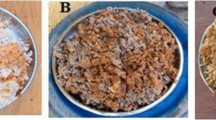Abstract
A fruity aroma-producing strain WG4 was isolated from a water sample collected from the Western Ghats, India. The 16S rRNA gene sequence analysis of strain WG4 indicated that Chryseobacterium indologenes, a member of the family ‘Flavobacteriaceae’ is the closest related species with a pair-wise sequence similarity of 98.6%. Strain WG4 produces a fruity aroma when grown on nutrient or trypticase soy agar plates. The fruity aroma is more when the strain WG4 is grown on agar plates compared to their growth in broth. The aromatic compounds produced by the strain WG4 were identified as ester compounds and were confirmed as ethyl-2-methylbutyrate and ethyl-3-methylbutyrate based on Gas Chromatography–Mass Spectrometry (GC–MS) analysis and using standard reference compounds. Even after repeated subcultures strain WG4 produced the same aroma in high intensity. Thus, strain WG4 could serve as a source for the production of these flavour compounds.

Similar content being viewed by others
References
Barbosa C, Falco V, Mendes-Faia A, Mendes-Ferreira A (2009) Nitrogen addition influences formation of aroma compounds, volatile acidity and ethanol in nitrogen deficient media fermented by Saccharomyces cerevisiae wine strains. J Biosci Bioeng 108:99–104
Bernardet J-F, Hugo C, Bruun B (2006) The genera Chryseobacterium and Elizabethkingia. In: Dworkin M, Falkow S, Rosenberg E, Schleifer K-H, Stackebrandt E (eds) The Prokaryotes. Springer-Verlag, New York, pp 638–676
Bernardet J-F, Segers P, Vancanneyt M, Berth F, Kersters K, Vandamme P (1996) Cutting a Gordion knot: emended classification and description of the genus Flavobacterium, emended description of the family Flavobacteriaceae, and proposal of Flavobacterium hydatis nom. nov. (basonym, Cytophaga aquatilis Strohl and Tait 1978). Int J Syst Bacteriol 46:128–148
Garruti DS, Franco MRB, Silva MAAP, Janzantti NS, Alves GL (2006) Assessment of aroma impact compounds in a cashew apple-based alcoholic beverage by GC–MS and GC–olfactometry. LWT—Food Sci Technol 39:373–378
Gonçalves B, Falco V, Moutinho-Pereira J, Bacelar E, Peixoto F, Correia C (2009) Effects of elevated CO2 on grapevine (Vitis vinifera L.): volatile composition, phenolic content, and in vitro antioxidant activity of red wine. J Agric Food Chem 57:65–273
Gonda I, Bar E, Portnoy V, Lev S, Burger J, Schaffer AA, Tadmor Y, Gepstein S, Giovannoni JJ, Katzir N, Lewinsohn E (2010) Branched-chain and aromatic amino acid catabolism into aroma volatiles in Cucumis melo L. fruit. J Exp Bot 61:1111–1123
Guindon S, Gascuel O (2003) A simple, fast, and accurate algorithm to estimate large phylogenies by maximum likelihood. Syst Biol 52:696–704
Hesta M, Janssens G, Debraekeleer J, Millet S, De Wilde R (2003) Fecal odor components in dogs: nondigestible oligosaccharides and resistant starch do not decrease fecal H2S emission. J Appl Res Vet Med 1:225–232
Hettinga KA, van Valenberg HJF, Lam TJGM, van Hooijdonk ACM (2008) Detection of mastitis pathogens by analysis of volatile bacterial metabolites. J Dairy Sci 91:3834–3839
Jetti RR, Yang E, Kurnianta A, Finn C, Qian MC (2007) Quantification of selected aroma-active compounds in strawberries by headspace solid-phase microextraction gas chromatography and correlation with sensory descriptive analysis. J Food Sci 72:S487–S496
Jooste PJ, Hugo CJ (1999) The taxonomy, ecology and cultivation of bacterial genera belonging to the family Flavobacteriaceae. Int J Food Microbiol 53:81–94
Jürgens A, Webber AC, Gottsberger G (2000) Floral scent compounds of Amazonian Annonaceae species pollinated by small beetles and thrips. Phytochemistry 55:551–558
Forsythe SJ (2000) The microbiology of safe food. Blackwell Science, Oxford
Labuda I (2009) Flavor compounds. In: Encyclopedia of microbiology, Academic Press, New York, pp 305–320
Longo MA, Sanromán MA (2006) Production of food aroma compounds: microbial and enzymatic methodologies. Food Technol Biotechnol 44:335–353
Mcfeeters RF (2004) Fermentation microorganisms and flavor changes in fermented foods. J Food Sci 69:35–37
Nychas GJE, Drosinos EH (1999) Meat and poultry. In: Robinson RK (ed) Encyclopedia of food microbiology. Academic Press, San Diego, pp 1253–1259
Omelianski VL (1923) Aroma-producing microörganisms. J Bacteriol 8:393–419
Pradhan S, Srinivas TNR, Pindi PK, Kishore KH, Begum Z, Singh PK, Singh AK, Pratibha MS, Yasala AK, Reddy GS, Shivaji S (2010) Bacterial biodiversity from Roopkund Glacier, Himalayan mountain ranges, India. Extremophiles 14:377–395
Reddy MC, Bills DD, Lindsay RC (2007) Ester production by Pseudomonas fragi. II. Factors influencing ester levels in milk cultures. Appl Microbiol 17:779–782
Rodríguez Madrera R, Suárez Valles B (2007) Determination of volatile compounds in cider spirits by gas chromatography with direct injection. J Chromatogr Sci 45:428–434
Saitou N, Nei M (1987) The neighbor-joining method: a new method for reconstructing phylogenetic trees. Mol Biol Evol 4:406–425
Srinivas TNR, Nageswara Rao SSS, Vishnu Vardhan Reddy P, Pratibha MS, Sailaja B, Kavya B, Hara Kishore K, Begum Z, Singh SM, Shivaji S (2009) Bacterial diversity and bioprospecting for cold-active lipases, amylases and proteases, from culturable bacteria of Kongsfjorden and Ny-Ålesund, Svalbard, Arctic. Curr Microbiol 59:537–547
Sumby KM, Grbin PR, Jiranek V (2010) Microbial modulation of aromatic esters in wine: current knowledge and future prospects. Food Chem 121:1–16
Wolochow H, Thornton HR, Hood EG (1942) Studies on surface taint butter. VI. Other bacterial species as causal agents. Flavobacterium maloloris (n. sp.). Sci Agric 22:637–644
Acknowledgments
We would like to thank Ram, M. S. from CCMB, Hyderabad, India for providing the sample. SS is thankful to CSIR Network Project on Exploitation of India’s rich microbial diversity (NWP0006) for funding. TNRS acknowledges the CSIR, Government of India for the award of Research Associateship.
Author information
Authors and Affiliations
Corresponding author
Electronic supplementary material
Below is the link to the electronic supplementary material.
284_2011_9966_MOESM1_ESM.ppt
Supplementary Fig. 1 Phylogenetic tree based on 16S rRNA gene sequences showing the relationship of Chryseobacterium sp. strain WG4 with the closely related members of the genus Chryseobacterium. Phylogenetic tree was constructed using the Maximum likelihood method. Elizabethkingia miricola GTC862T was used as an out group. Numbers at nodes are bootstrap values. The bar represents 0.01 substitutions per alignment position. (PPT 115 kb)
Rights and permissions
About this article
Cite this article
Kumar, P.A., Srinivas, T.N.R., Prasad, A.R. et al. Identification of Fruity Aroma-Producing Compounds from Chryseobacterium sp. Isolated from the Western Ghats, India. Curr Microbiol 63, 193–197 (2011). https://doi.org/10.1007/s00284-011-9966-5
Received:
Accepted:
Published:
Issue Date:
DOI: https://doi.org/10.1007/s00284-011-9966-5




